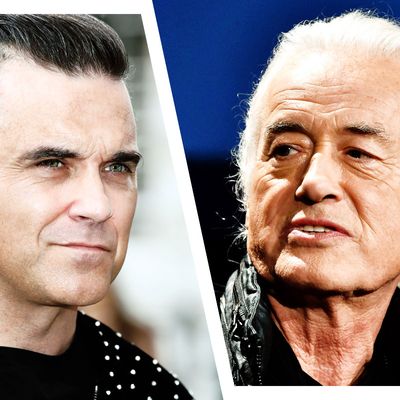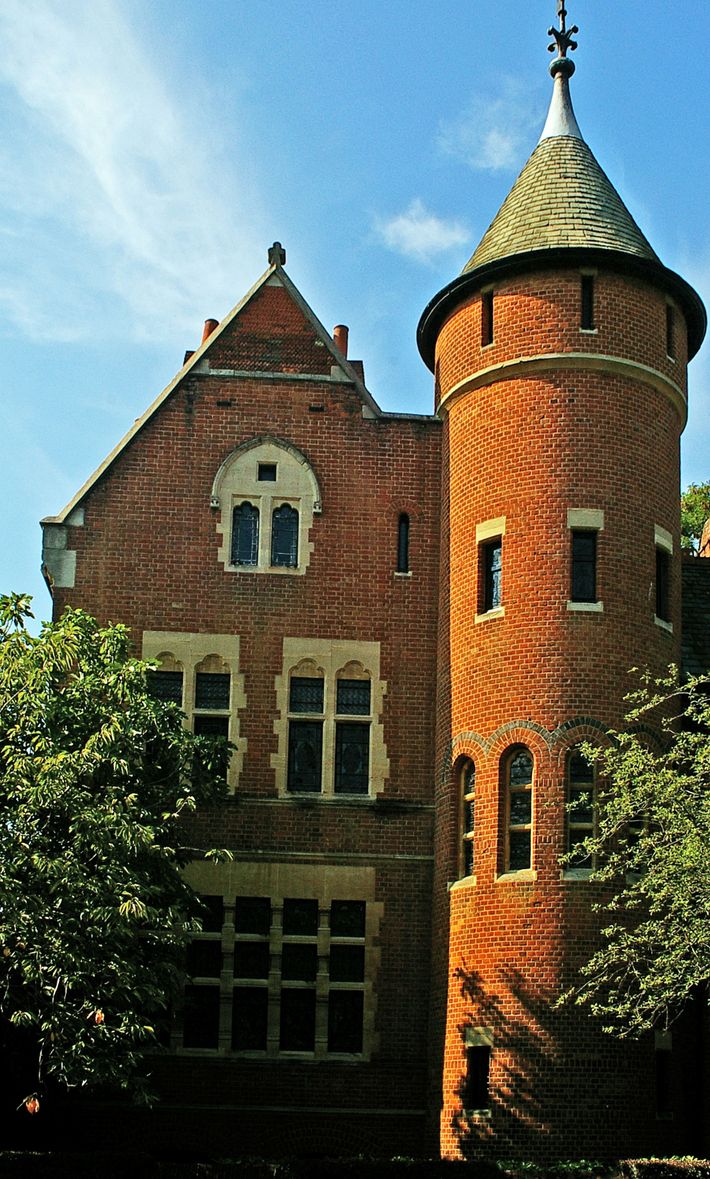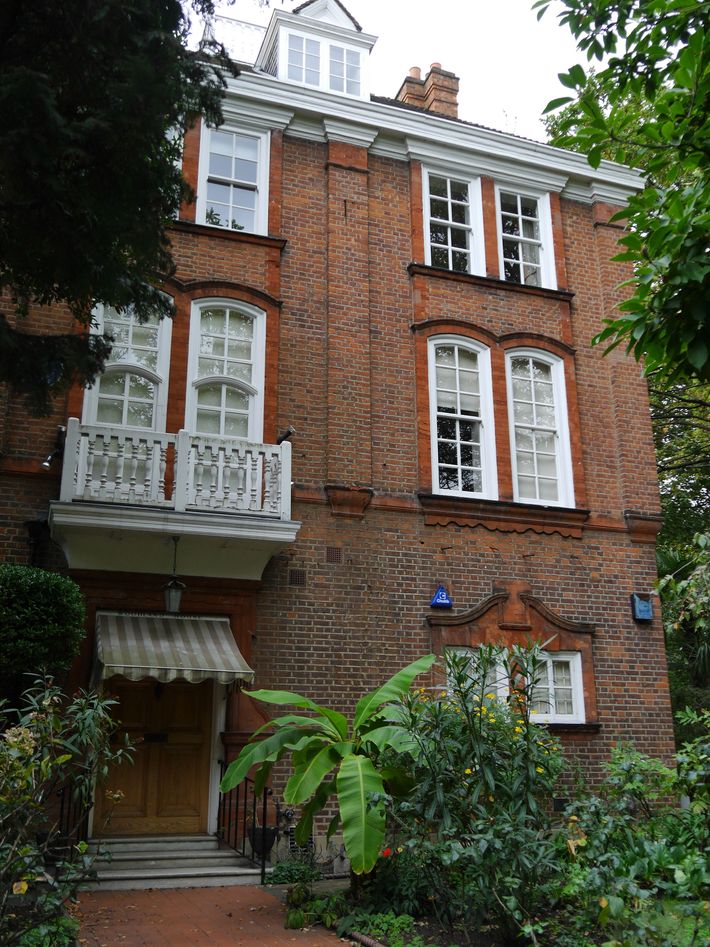
No matter what happens in the world, we can always distract ourselves by seeking refuge in the Magic 8-Ball of petty celebrity feuds. Who will be next?! And what will prove to be the catalyst of such succulent beef?! Well, if we were to look overseas to the fancy London confines of Holland Park, the answers would be “Jimmy Page,” “Robbie Williams,” and, um, “grandiose mansion expansions,” respectively. That’s because over the past five years, the Led Zeppelin guitar doyen and the Take That crooner have been engaged in a never-ending neighbor feud over Williams’s plans to modernize his house, which Page believes will depreciate, and even physically impair, his historic abode. There have been feisty interviews, council appearances, a peacock invasion … you name it! But what there hasn’t been is any official truce.
While you perhaps only came across the men’s feud recently due to a particularly silly power move by Williams, Vulture decided that it was 100 percent in the best interest of our readers to expound on everything that has gone down between these British icons. What ensues is a timeline that’s less about rich-people problems and more about … historical preservation?
Summer 1972: In between recording Led Zeppelin IV and Houses of the Holy, Page purchases the Tower House, which was built by William Burges as his primary residence in the late 19th century. In yet another musician showdown, he manages to outbid David Bowie for the digs, with £350,000 proving to be the winning sale. In an interview decades later, Page said the reason he was so infatuated with the house was due to his interest in the pre-Raphaelite movement and Burges’s unique architectural aesthetic. “I was still finding things 20 years after being there — a little beetle on the wall or something like that,” Page told the BBC. “It’s Burges’s attention to detail that is so fascinating.” That French Gothic Revival style — hubba-hubba!

December 2013: Williams purchases the historic Woodland House, which is adjacent to Page’s Tower House, as his main residence to raise his children with his wife. (It was also built in the late 19th century.) He pays £17.5 million for it. We love a good English Baroque look.

December 2014: The drama, and the paperwork, officially begins. Williams submits a planning permit to begin construction on his house, which he believes is necessary to create a “contemporary standard of family living.” This includes roof repair, extensive tweaks to the internal layout, and an entire new subterranean floor. Also, some garden work.
About a month after Williams’s proposal is submitted, Page sends a letter of complaint to the Royal Borough of Kensington and Chelsea, believing the severity of the intended construction will damage his house. “I am extremely concerned that this work will cause vibrations and possible structural damage,” Page wrote, but he’s also hot and bothered about the potential addition of a window: “It appears the proposed new window is at a height that will overlook the side of my house as well as the garden at the rear of my property, thus having a significant impact on the amenity of the house and its garden.” As someone who prides himself in preserving the house’s historic architecture for over 40 years, Page adds, “I am now faced with having to fight a new threat to this precious and unique building.”
March 2015: Page seemingly secures an early victory: Williams withdraws every single one of his renovation plans.
April 2015: Psych! Williams is back with some plans, baby, and they’re new and improved. The ambitious basement extension has been replaced with mostly internal restructuring, such as knocking down walls and lowering a few floors to create an open-plan layout. He also wants to demolish the garage and build a new one from scratch. Despite this retreat in plans, Page is still wholly unamused and fires some poetic ammo yet again. He submits another letter to the borough planning chiefs that urges them to refuse Williams’s proposal, once again citing the structural damage his house could face as a result of the construction. He also lays this burn on the intended garage design: “Extremely unfortunate in architectural terms.”
July 2015: It’s a win for Williams. The borough planning chiefs officially rule that his current renovation plans pose “no harm to Tower House.”
October 2015: Taking the summer to fume and plan his revenge, Page strikes. Hiring an architectural firm to investigate and report to the borough if Williams is carrying out unauthorized construction work, it turns out, he indeed is. The Construction Traffic Management Plan for Williams’s house gets rejected due to failure to ensure the “safeguard [and] living conditions of occupiers of surrounding properties,” but builders are still seen working, which leads to the borough shutting down construction. However, a few weeks later, construction is cleared to begin once again.
February 2016: Page gets a key ally. A widow who previously lived in Williams’s house for decades, Geraldine Winner, is enraged at the plans to cut down trees in the backyard and rip out nearly all the plants and flora. (Now is probably a good time to mention that the previous owner, director Michael Winner, died in the house in early 2013.) “Michael planted them when they were just a foot high. He loved his garden, and did a lot of work in it,” she tells the Daily Mail. In his proposal, Williams previously described the garden with disdain, saying it didn’t match the “British woodland” vibe he wanted to cultivate. Months later, Page gets even more allies thanks to his neighbors, who do various interviews with the Daily Mail to also express their annoyance at the construction.
September 2016: In his first interview about their ongoing feud, Williams believes he’s the victor and finds the whole ordeal amusing. “I won. Did we win? I don’t know if there are any winners, necessarily. I do know it makes a great story and I’m really pleased, just for me in general for the rest of my life. I’m really pleased it’s Jimmy Page and not Jimmy the accountant,” he told The Sun. “But it’s a great story, for you guys and for me, so everybody wins. Apart from us as a family, who would have liked to have been in 12 months ago but we can’t.”
October 2016: Williams and his family move into the house, nearly three years after purchasing it.
Mid-November 2016: Williams expounds on his beef with Page in an interview with an Italian radio station, and his words get much sharper — mostly because he was unaware he was still being recorded after cutting to a commercial break. Likening Page to a man with “mental illness,” Williams believes he’s a “bored” musician who has nothing better to do than spy on the construction. “Jimmy has been sitting in his car outside our house with the windows down, four hours at a time with a recording equipment,” he alleged. “He’s recording the workmen to see if they’re making too much noise. And also two weeks ago, the builders came in and he was asleep in his garden, waiting.”
To add insult to injury, Geraldine Winner releases a Twitter statement to express admiration for the renovations. In a separate interview with Radio Times a few weeks later, Williams also declares Page as “more than a tit.”
Late November 2016: In the midst of the feud, Williams’s wife, Ayda Field, hires a Native American healer to cleanse their mansion of any spiritual trace of Michael Winner, because she feels he’s “watching over” her. “I am going to have it blessed, saged, the whole L.A. thing,” she said on the U.K. talk show Loose Women. “I am kind of concerned.”
April 2017: Williams submits a new proposal to build a large shed on stilts in his backyard, which is described as a “relaxation space” for his family. Surprisingly, Page doesn’t object to this proposal, and building commences on it a few months later.
May 2017: What Page does object to, though, are loud sounds, and he lodges a noise complaint against Williams’s construction company for dismantling a shed on a Sunday. The borough’s findings confirm that the company was indeed using illicit power tools on a day when strict noise limits were in place, and the company is subsequently fined £3,000.
June 2017: Williams walks back the assertion that Page was spying on him and his house, and issues a formal apology for his comments. “Jimmy Page has explained to me that certain specific factual assertions which I made were in fact not true and I am happy to accept what Jimmy Page says,” he said, in part. “I understand why Jimmy Page will have found my comments offensive and I apologize for any hurt that they have caused him and his family as a result.”
February 2018: After enjoying a period of peace, Williams revives his most daring construction idea yet: building a subterranean floor, complete with a pool, gym, and shower alcove. Page goes berserk in a letter of complaint to the borough planning chiefs and requests the immediate refusal of these “catastrophic” plans. “I am now continuing the fight against a new threat to this precious and unique building,” Page writes, among pages and pages of rebuttals. His biggest concern, as has been in the past, is the “alarming level of vibration” the construction will bring to his historic house. This time, Williams decides to fight back … with research. He hires a property consultant firm to fact-check and address each of Page’s assertions in the letter, with the firm deeming the majority of his concerns to be without merit. In fact, using colorful flourish, Page’s house is deemed a “fortress” that could survive a “Second World War bombing.”
April 2018: Williams and Page’s backyards and cars are for some reason being overrun by an escaped gang of peacocks. We’re not kidding.
May 2018: Ahead of the Royal Borough of Kensington and Chelsea’s official ruling on Williams’s basement, Page begins a press blitz to make people aware of the extent of his passion and commitment to preserving Tower House — and especially wants it known that he isn’t going to cede just because a superrich crooner has the money to spend. He even appears in person at the planning and applications meeting later in the month to plead his case. “Tower House is a unique building,” he explains to the council. “You do need to see it to fully understand why I am here today as custodian of this wonderful, delicate, heritage building, and treasure.”
June–September 2018: Page’s press blitz continues with various interviews as he awaits the council’s verdict, and he invites three outlets into his home to show off its historic beauty. One of these interviews, with ITV News, generates headlines when Page insults the “idiotic” and “tasteless” Williams.
December 2018: Judgment day finally arrives, and Page’s worst fears come true: The Royal Borough of Kensington and Chelsea grant permission for Williams to build his dream basement, on the condition he can provide evidence the construction’s vibration levels will never exceed a certain level. The chair of the committee also expresses hope that their saga will just go away, likening the men’s feud to Brexit.
January 2019: An anonymous neighbor of Page and Williams sends a letter to the borough planning chiefs, saying Williams is frequently engaging in petty tomfoolery in the aftermath of his victory. “The committee may not have been aware that Robbie Williams has been playing loud 70’s rock music on outside speakers when he views Jimmy Page outside his home,” the neighbor writes, mentioning rival bands Black Sabbath, Pink Floyd, and Deep Purple as the favored tunage. Williams also apparently enjoys dressing up as fellow Led Zeppelin-er Robert Plant — long wig, full stomach, etc. — when he leaves his house, with the sole purpose of pissing off Page.


